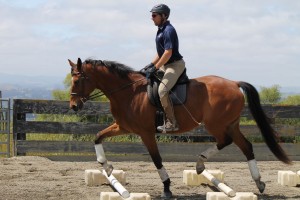Cavalletti can be an effective and fun way to train your horse and develop your relationship with them. Cavalletti have been in use since around the beginning of last century with the advent of the forward seat developed by trainers like Federico Caprilli. This early work over poles on the ground or over low standards at different gaits became part of the Italian Cavalry School whose training initiated the style of modern jumping we see today. Then cavalletti training gradually integrated into other European riding institutions. As formal training moved away from the military and into the general public, cavalletti training became a part of the modern training curriculum to one degree or another.
This practice of using cavalletti training for modern horses progressed greatly when Reiner Klimke wrote his book Cavalletti first published in 1969. This book has been so popular and well received it has gone through many reprintings and now has evolved into a new edition where Klimke’s daughter Ingrid Klimke collaborated with him for a new edition.
The universality of cavalletti makes them a useful application within any riding program regardless of discipline and breed. For jumping horses the advantages are more obvious since cavalletti can be used as part of the progression of teaching them to jump over higher and more complicated fences. Dressage horses can improve their gaits. Trail horses can be made more handy and agile.
Like all training, it is only as good as it is practiced. It is important to apply the cavalletti training with good technique and skill. First let us look at some of the underlying characteristics of cavalletti training that help both horses and riders.
- Strength, suppleness and straightness—We put these three principles together since they are part of the same process of the horse moving forward in balance. By stepping over the poles in succession the horse needs to lift his legs higher which improves his capacity to thrust himself forward. This movement also encourages stretching through his topline and reach with his legs. This higher and longer stride helps the horse develops a loose but powerful gait.
- Rider Balance and equitation—The ability of the rider to keep correct posture is paramount to staying in balance with the horse and being able to effectively communicate with horse. Riders practice keeping correct position going over cavalletti as well as improve their sense of timing and coordination in staying with the motion of their horse.
- Confidence and Focus—All training needs to be done with both the horse and rider having the same picture of the activity they are doing. This focus needs to very clear but done in a state of relaxation. As the horse and rider pair move through a succession of increasing difficulty in cavalletti exercises, both become more confident at the same time doing the task at hand with greater ease. This process creates a positive cycle where confidence and focus lead to greater relaxation and harmony and vice versa.
- Relationship—The overarching principle of developing our relationships with our horses is central to all of the work we do with them. Qualities like harmony, connected movement, and joy can be expressed with proper work through cavalletti. We can also see where there is a breakdown in physical capability and communication and address any problems as they arise in a clear and compassionate manner.
Integrating cavalletti into your training can help you and your horse become more confident and capable as well as create the harmonious relationship we all want with our horses. Most importantly, cavalletti training is an effective and fun way to spend time with our horses. For more specific information on using cavalletti for your training contact Jack at J-Dot Stables.
